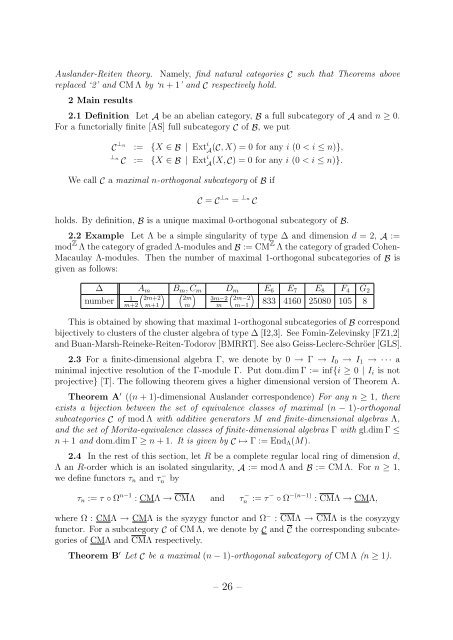HIGHER DIMENSIONAL AUSLANDER-REITEN THEORY ON ...
HIGHER DIMENSIONAL AUSLANDER-REITEN THEORY ON ...
HIGHER DIMENSIONAL AUSLANDER-REITEN THEORY ON ...
Create successful ePaper yourself
Turn your PDF publications into a flip-book with our unique Google optimized e-Paper software.
Auslander-Reiten theory. Namely, find natural categories C such that Theorems above<br />
replaced ‘2’ and CM Λ by ‘n + 1’ and C respectively hold.<br />
2 Main results<br />
2.1 Definition Let A be an abelian category, B a full subcategory of A and n ≥ 0.<br />
For a functorially finite [AS] full subcategory C of B, we put<br />
C ⊥n := {X ∈ B | Ext i A ( C, X) = 0 for any i (0 < i ≤ n)},<br />
⊥ n<br />
C := {X ∈ B | Ext i A (X, C) = 0 for any i (0 < i ≤ n)}.<br />
We call C a maximal n-orthogonal subcategory of B if<br />
C = C ⊥n = ⊥n C<br />
holds. By definition, B is a unique maximal 0-orthogonal subcategory of B.<br />
2.2 Example Let Λ be a simple singularity of type ∆ and dimension d = 2, A :=<br />
mod Z Λ the category of graded Λ-modules and B := CM Z Λ the category of graded Cohen-<br />
Macaulay Λ-modules. Then the number of maximal 1-orthogonal subcategories of B is<br />
given as follows:<br />
∆ A m B m , C m D m E 6 E 7 E 8 F 4 G<br />
( ) ( ) ( ) 2<br />
1<br />
number 2m+2 2m 3m−2 2m−2<br />
m+2 m+1 m m m−1 833 4160 25080 105 8<br />
This is obtained by showing that maximal 1-orthogonal subcategories of B correspond<br />
bijectively to clusters of the cluster algebra of type ∆ [I2,3]. See Fomin-Zelevinsky [FZ1,2]<br />
and Buan-Marsh-Reineke-Reiten-Todorov [BMRRT]. See also Geiss-Leclerc-Schröer [GLS].<br />
2.3 For a finite-dimensional algebra Γ, we denote by 0 → Γ → I 0 → I 1 → · · · a<br />
minimal injective resolution of the Γ-module Γ. Put dom.dim Γ := inf{i ≥ 0 | I i is not<br />
projective} [T]. The following theorem gives a higher dimensional version of Theorem A.<br />
Theorem A ′ ((n + 1)-dimensional Auslander correspondence) For any n ≥ 1, there<br />
exists a bijection between the set of equivalence classes of maximal (n − 1)-orthogonal<br />
subcategories C of mod Λ with additive generators M and finite-dimensional algebras Λ,<br />
and the set of Morita-equivalence classes of finite-dimensional algebras Γ with gl.dim Γ ≤<br />
n + 1 and dom.dim Γ ≥ n + 1. It is given by C ↦→ Γ := End Λ (M).<br />
2.4 In the rest of this section, let R be a complete regular local ring of dimension d,<br />
Λ an R-order which is an isolated singularity, A := mod Λ and B := CM Λ. For n ≥ 1,<br />
we define functors τ n and τn<br />
− by<br />
τ n := τ ◦ Ω n−1 : CMΛ → CMΛ and τ − n := τ − ◦ Ω −(n−1) : CMΛ → CMΛ,<br />
where Ω : CMΛ → CMΛ is the syzygy functor and Ω − : CMΛ → CMΛ is the cosyzygy<br />
functor. For a subcategory C of CM Λ, we denote by C and C the corresponding subcategories<br />
of CMΛ and CMΛ respectively.<br />
Theorem B ′ Let C be a maximal (n − 1)-orthogonal subcategory of CM Λ (n ≥ 1).<br />
– 26 –















